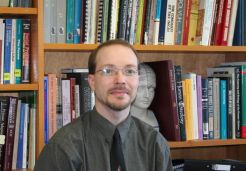
Associate Professor, Anthropology
Human Biology and Adaptation, Osteology, Paleopathology, Growth and Development, Bioarchaeology, Nutrition and Disease
Carnegie Hall, 04d
651-696-6925
[email protected]
he/him/his
Fall 2022 Courses
General Anthropology
Human Evolution
Spring 2023 Courses
Biological Anthropology
Darwin & Evolutionary Thought
#macvid(“scottlegge”)
 Professor Scott Legge is a biological anthropologist with research interests in human and non-human primate skeletal biology as well as areas of growth and development in both skeletal and living populations. Specifically, he has conducted research into vertebral pathologies in skeletal collections of native Alaskans and pathological conditions of the skeleton in great apes and Old World monkeys. Additionally, his research into the developmental processes of skeletal maturation in subadults resulted in a method for the estimation of the age of puberty in skeletal populations based on epiphyseal fusion of those bones known to fuse at or near the time of puberty.
Professor Scott Legge is a biological anthropologist with research interests in human and non-human primate skeletal biology as well as areas of growth and development in both skeletal and living populations. Specifically, he has conducted research into vertebral pathologies in skeletal collections of native Alaskans and pathological conditions of the skeleton in great apes and Old World monkeys. Additionally, his research into the developmental processes of skeletal maturation in subadults resulted in a method for the estimation of the age of puberty in skeletal populations based on epiphyseal fusion of those bones known to fuse at or near the time of puberty.
Professor Legge’s recent publications include:
Irish, Joel D., Debbie Guatelli-Steinberg, Scott S. Legge, Darryl J. de Ruiter, and Lee R. Berger. 2014. News and views: Response to ‘Non-metric dental traits and hominin phylogeny’ by Carter et al., with additional information on the Arizona State University Dental Anthropology System and phylogenetic ‘place’ of Australopithecus sediba. Journal of Human Evolution In press.
Hardin, Anna M, and Scott S Legge. 2013. Evaluation of the utility of deciduous molar morphological variation in great ape phylogenetic analysis. Dental Anthropology 26 (1-2):5-14.
Hardin, Anna M, and Scott S Legge. 2013. Geographic Variation in Nonmetric Dental Traits of the Deciduous Molars of Pan and Gorilla. International Journal of Primatology 34 (5):1000-1019.
Irish, J. D., D. Guatelli-Steinberg, S. S. Legge, D. J. de Ruiter, and L. R. Berger. 2013. Dental morphology and the phylogenetic “place” of Australopithecus sediba. Science 340 (6129).
Legge, Scott S. 2012. Dentoalveolar abscess variation among three groups of chimpanzees (Pan troglodytes schweinfurthii, Pan troglodytes troglodytes, and Pan paniscus). International Journal of Paleopathology 2 (1):1-9.
Professor Legge’s background and training are in all four fields of anthropology: archaeology, biological anthropology, cultural anthropology, and linguistic anthropology, with a specialization in biological anthropology. He received his Ph.D. in anthropology from the University of Alaska, Fairbanks (2002) following the completion of an M.A. in anthropology at Southern Illinois University (1995) and a B.A. in anthropology from Purdue University (1991). He has academic and research experience in human variation, human population biology, bioarchaeology, and skeletal biology, as well as extensive experience in historic and precontact archaeology. Prior to coming to Macalester he taught at the University of Kent, Canterbury, UK. While there he helped develop new undergraduate programs in Biological and Medical Anthropology. He was also part of a research group of three anthropology staff members who won the 2007 Social Sciences Faculty Teaching Prize.
Professor Legge’s Ph.D. research included the examination of vertebral pathologies in skeletal collections from Golovin Bay and Nunivak Island, Alaska. He examined the patterns of the pathological conditions and analyzed them with regard to traditional subsistence resource strategies for two different geographic regions within Alaska. He also compared the patterns observed with published data from other geographic regions, both within and outside of the Arctic.
His teaching interests include: Human Biology and Adaptation, Osteology, Paleopathology, Growth and Development, Bioarchaeology, Nutrition and Disease.
For more information, go to this link:
Works.Bepress.Com/Scott_legge/
Anthropology April Fools’ Day
#photoset(“72157633199314560”)
In 2009, students in First Year Course “Evolutionary Anthropology: Fact, Fantasies, and Frauds” taught by Professor Scott Legge, studied the question of what is scientific research and evaluated Sasquatch/Big Foot research to decide whether it qualified as scientific. Four years later, these students honored Professor Legge with an elaborate April Fools Big Foot display.